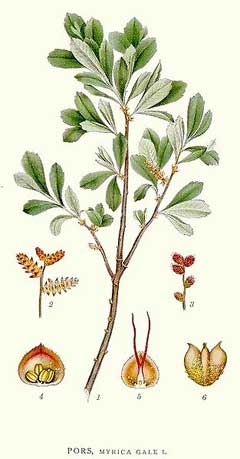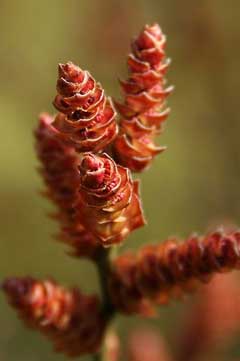 |
|
http://commons.wikimedia.org/wiki/File:375_Myrica_gale.jpg |
 |
| http://commons.wikimedia.org/wiki/User:Sten |
Translate this page:
Summary
Physical Characteristics

 Myrica gale is a deciduous Shrub growing to 2 m (6ft) by 1 m (3ft 3in).
Myrica gale is a deciduous Shrub growing to 2 m (6ft) by 1 m (3ft 3in).
See above for USDA hardiness. It is hardy to UK zone 1. It is in flower from March to May, and the seeds ripen from August to September. The species is dioecious (individual flowers are either male or female, but only one sex is to be found on any one plant so both male and female plants must be grown if seed is required). and is pollinated by Wind. The plant is not self-fertile.
It can fix Nitrogen.
It is noted for attracting wildlife.
Suitable for: light (sandy), medium (loamy) and heavy (clay) soils. Suitable pH: mildly acid, neutral and basic (mildly alkaline) soils and can grow in very acid soils.
It can grow in semi-shade (light woodland) or no shade. It prefers moist or wet soil.
UK Hardiness Map
US Hardiness Map
Synonyms
M. palustris. Gale palustris.
Plant Habitats
Woodland Garden Sunny Edge; Dappled Shade; Bog Garden;
Edible Uses
Edible Parts: Fruit
Edible Uses: Condiment Tea
The aromatic fruits and leaves are used either fresh or dried to flavour soups, stews etc[2, 4, 62, 100, 183]. They are sometimes put in beer and ale to improve the flavour and increase foaming[183]. The fruit is about 3mm in diameter with a single large seed[200]. The dried leaves make a delicate and palatable tea[4, 62, 172, 183].
References More on Edible Uses
Medicinal Uses
Plants For A Future can not take any responsibility for any adverse effects from the use of plants. Always seek advice from a professional before using a plant medicinally.
Abortifacient Antipruritic Aromatic Astringent Emmenagogue Parasiticide Stomachic
The leaves are abortifacient, aromatic, astringent, emmenagogue and stomachic[4, 46, 172, 238]. The leaves are normally used as a tea, but they do contain a poisonous aromatic oil, so some caution is advised in their use[4].
References More on Medicinal Uses
The Bookshop: Edible Plant Books
Our Latest books on Perennial Plants For Food Forests and Permaculture Gardens in paperback or digital formats.

Edible Tropical Plants
Food Forest Plants for Hotter Conditions: 250+ Plants For Tropical Food Forests & Permaculture Gardens.
More

Edible Temperate Plants
Plants for Your Food Forest: 500 Plants for Temperate Food Forests & Permaculture Gardens.
More

More Books
PFAF have eight books available in paperback and digital formats. Browse the shop for more information.
Shop Now
Other Uses
Dye Essential Parasiticide Repellent Tannin Wax
A wax covering on the fruit and leaves is extracted by scalding the fruit with boiling water and immersing them for a few minutes, the wax floats to the surface and is then skimmed off. The fruit is then boiled in water to extract the wax from the pulp and once more the wax is skimmed off. It is then strained through a muslin cloth and can be used to make aromatic candles[4, 6, 245]. These candles diffuse a delightful odour when burnt[245]. Unfortunately this species does not produce enough wax to make it commercially viable[115]. A yellow dye is obtained from the stem tips[66, 115, 172]. Brown according to another report[257]. A yellow dye is obtained from the seeds[257]. The bark contains tannin and can be gathered in the autumn and used as a yellow dye[4]. The plant repels moths and insects in general[66, 106, 115]. The fragrant leaves are used[4, 100]. A strong decoction of the leaves can be used as a parasiticide to kill external body parasites[172]. A fragrant essential oil is obtained from the fruits[115]. Nitrogen Fixer.
Special Uses
Attracts Wildlife Food Forest Nitrogen Fixer Scented Plants
References More on Other Uses
Cultivation details
There is some difference of opinion about the needs of this plant. Most reports say that it prefers a moist soil and that it grows well in an open position in a well-drained soil in sun or light shade. Most reports also say that it prefers or even requires a lime-free loamy or peaty soil[1, 200] but another report says that it succeeds in any ordinary garden soil[11]. In the wild it is usually found in soils with a pH between 3.5 and 6, but it is also sometimes found in fens with a pH as high as 7.5[186]. A suckering shrub, when well sited it can form thickets[186]. This species has a symbiotic relationship with certain soil micro-organisms, these form nodules on the roots of the plants and fix atmospheric nitrogen. Some of this nitrogen is utilized by the growing plant but some can also be used by other plants growing nearby[200].This habit also allows the plant to succeed in water-logged soils[186]. Dioecious. Male and female plants must be grown if seed is required. This plant is occasionally monoecious and also can change sex from year to year[50]. Flowers are produced mainly on one-year old wood[4]. All parts of the plant are pleasantly aromatic[186]. A good food plant for the caterpillars of many species of butterflies[30]. Plants in this genus are notably resistant to honey fungus[200]. The plant is heat tolerant in zones 6 through 1. (Plant Hardiness Zones show how well plants withstand cold winter temperatures.
Plant Heat Zones show when plants would start suffering from the heat.
The Plant Heat Zone map is based on the number of "heat days" experienced in a given area where the temperature climbs to over 86 degrees F (30°C).
At this temperature, many plants begin to suffer physiological damage. Heat Zones range from 1 (no heat days) to 12 (210 or more heat days).
For example Heat Zone. 11-1 indicates that the plant is heat tolerant in zones 11 through 1.) For polyculture design as well as the above-ground architecture (form - tree, shrub etc. and size shown above) information on the habit and root pattern is also useful and given here if available. The plant growth habit is multistemmed with multiple stems from the crown [1-2]. The root pattern is stoloniferous rooting from creeping stems above the ground [1-2].
References Carbon Farming Information and Carbon Sequestration Information
Temperature Converter
Type a value in the Celsius field to convert the value to Fahrenheit:
Fahrenheit:
The PFAF Bookshop
Plants For A Future have a number of books available in paperback and digital form. Book titles include Edible Plants, Edible Perennials, Edible Trees,Edible Shrubs, Woodland Gardening, and Temperate Food Forest Plants. Our new book is Food Forest Plants For Hotter Conditions (Tropical and Sub-Tropical).
Shop Now
Plant Propagation
Seed - best sown as soon as it is ripe in the autumn in a cold frame. Barely cover the seed and keep it moist. Stored seed germinates more freely if given a 3 month cold stratification and then sown in a cold frame. Germination is usually good[78]. Prick out the seedlings into individual pots when they are large enough to handle and grow on in the cold frame for the first winter. Plant out in late spring or early summer[K]. Cuttings of half-ripe wood, 5 - 8cm with a heel, July/August in a frame. Pot up and overwinter in a cold frame. Fair to good percentage[78]. Cuttings of mature wood in November/December in a frame. Layering in spring[200]. Division of suckers in the dormant season. Plant them out direct into their permanent positions.
Other Names
If available other names are mentioned here
Native Range
TEMPERATE ASIA: Habarovskij kraj, Hokkaidô, Honshu (east), Japan, Kamcatskij kraj, Korea, North, Primorye, Sakhalin,Russian Federation. NORTHERN AMERICA: Canada, Northwest Territories (south), Yukon, Québec, Nova Scotia, Ontario, Prince Edward Island, New Brunswick, Newfoundland and Labrador, Saskatchewan, Alberta, Manitoba, British Columbia, United States, Alaska, Connecticut, Maine, Massachusetts, Michigan, New Hampshire, New Jersey (north), New York, Ohio (Seneca Co. (extirpated?)), Pennsylvania (northeast), Rhode Island, Vermont, Minnesota (north), Wisconsin, Oregon (northwest), Washington (west), North Carolina (west), EUROPE: Denmark, Finland, United Kingdom (U.K.), Ireland, Norway, Sweden, Belgium, Germany (north), Netherlands, Poland (north & west), Russian Federation-European part, European part (northwest), Estonia, Lithuania, Latvia, Spain (west), France (north & west), Portugal (west),
Weed Potential
Right plant wrong place. We are currently updating this section.
Please note that a plant may be invasive in one area but may not in your area so it's worth checking.
Conservation Status
IUCN Red List of Threatened Plants Status :

Growth: S = slow M = medium F = fast. Soil: L = light (sandy) M = medium H = heavy (clay). pH: A = acid N = neutral B = basic (alkaline). Shade: F = full shade S = semi-shade N = no shade. Moisture: D = dry M = Moist We = wet Wa = water.
Now available:
Food Forest Plants for Mediterranean Conditions
350+ Perennial Plants For Mediterranean and Drier Food Forests and Permaculture Gardens.
[Paperback and eBook]
This is the third in Plants For A Future's series of plant guides for food forests tailored to
specific climate zones. Following volumes on temperate and tropical ecosystems, this book focuses
on species suited to Mediterranean conditions—regions with hot, dry summers and cool, wet winters,
often facing the added challenge of climate change.
Read More
Expert comment
Author
L.
Botanical References
1117200
Links / References
For a list of references used on this page please go here
Readers comment